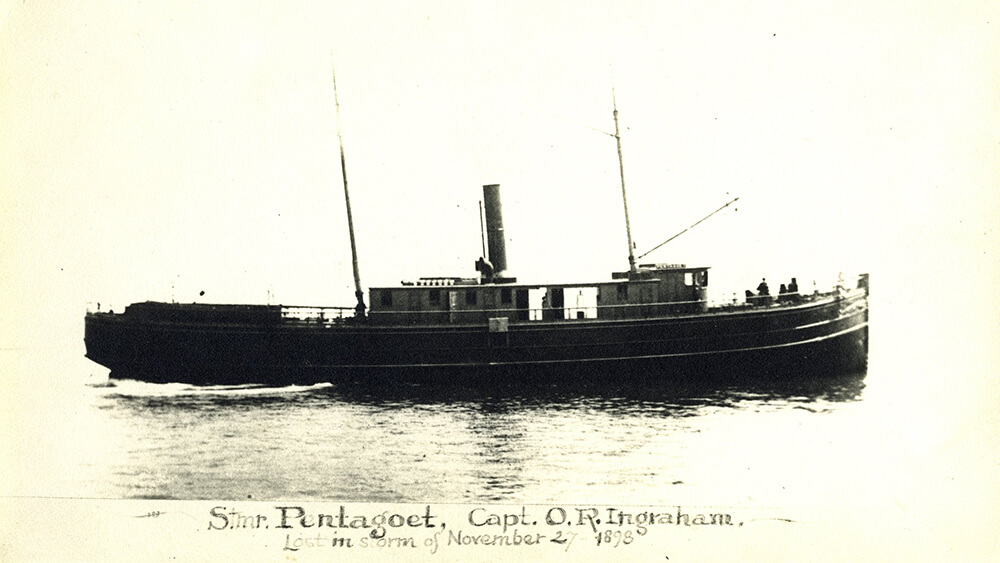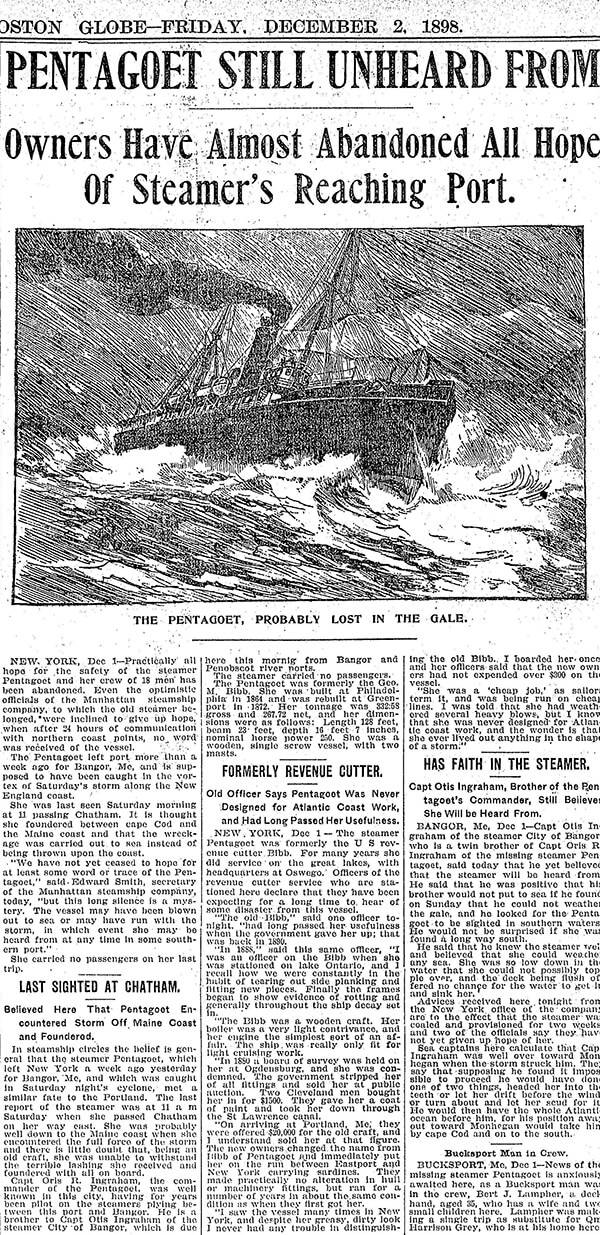Pentagoet (possible sanctuary wreck)

Ship Stats
Depth: over 100 feet
Length: 128.8 feet Breadth: 23 feet Depth of Hold: 16.7 feet
Tonnage: 332 gross tons
Built: 1864, wooden-hulled single screw steamship, originally called Hero, in Philadelphia, Pennsylvania
Port of Registry: USA
Owners: S. and J. M. Flannagan (1864); U.S. government (Navy 1864-1865; U.S. Revenue Service 1865-1891); George H. Kimball (1891-1898); Manhattan Steamship Company (1898)
Renamed and Refit: The U.S. Navy rechristened Hero as USS Moccasin in 1864; renamed U.S.R.C (United States Revenue Cutter) Moccasin in 1865 by the U.S. Revenue Service; underwent extensive repairs in 1881 (adding approximately 20 feet in length) and renamed U.S.R.C George M. Bibb; sold to George H. Kimball in 1891, underwent further modifications and renamed again, Pentagoet.
Date Lost: November 26 or 27,1898
Cargo at Time of Sinking: 150 tons of general freight, including merchandise fo the upcoming Christmas holiday
Owner at Time of Sinking:Manhattan Steamship Company
Crew: 18
Sunk By: Portland Gale of 1898 Survivors: 0 out of 18 (no survivors)
Data Collected on Site: Multi-beam sonar; drop camera; side-scan sonar; ROV photography and video
Significance: Pentagoet was one of two ships lost in sanctuary waters during the vicious Portland Gale of 1898. While overshadowed by the loss of Portland, Pentagoet had the second highest loss of life for any vessel during this storm with none of its 18 crew surviving. Additionally, the vessel had a varied and lengthy career, serving in the Civil War and as a revenue cutter and a passenger steamship in the mid and North Atlantic and the Great Lakes. To suit these diverse purposes, industries, and marine environments, it was refitted, repaired, and remodeled on several occasions. These alterations and adaptations provide windows into 19th century nautical technology, repair, and reuse.
Present Day
The shipwreck is mostly buried in sand up to the turn of the bilge. The site's most prominent features are an iron post projecting 10 feet above the seafloor at its northeast end and a large quantity of iron stud link anchor chain stretched across the site. The anchor chain is wrapped around the base of the iron post and runs though the center of the site and off into the sand. At the site's southwest end, the chain is threaded through both of the vessel's hawse pipes. Normally, hawse pipes would indicate the vessel's bow; however, the splayed out anchor chain suggests that it was dragged across the site by a trawl net thereby displacing the hawse pipes. Near the iron post, archaeologists found a larger anchor mostly buried in the sediment. The proximity of the anchor to the site's northeast end suggests that the iron post may be a stempost or sampson post. Only a small amount of the vessel's wooden hull is visible above the sand. Portions of the vessel's keelson protrude from the sand along its center line while frame ends delineate the site's outline. Small amounts of coal were spread widely across the site suggesting its use for transporting fuel rather than cargo. Before the sanctuary was designated, divers reportedly recovered pieces of a steam engine. Further archaeological investigation is necessary to conclusively determine whether the shipwreck is indeed the steamship Pentagoet.
Historical Background

Click to view full size
Pentagoet began life as the wooden-hulled single-screw steamship, Hero. The vessel's propulsion system consisted of a single boiler providing steam to a vertical direct-acting steam engine with a 34-inch cylinder diameter and a 32-inch stroke. The steamer had a gross tonnage of 192 tons, two masts, a plumb bow, and a round stern. Built in Philadelphia, Pennsylvania in 1864 for commercial purposes, the U.S. government purchased the vessel from its owners S. and J. M. Flannagan in July 1864 for use as a coastal patrol boat off Delaware, Maryland, Virginia, North Carolina, and South Carolina. Renamed the USS Moccasin, the steamer operated as part of the U.S. Navy until August 1865. In September 1865, the U.S. Treasury Department purchased the steamer for the U.S. Revenue Service. The U.S.R.C. Moccasin was first stationed at Norfolk, Virginia and in 1866 moved to Wilmington, North Carolina. After Wilmington, Moccasin was stationed in Rhode Island and South Carolina. In the spring of 1881, Moccasin underwent extensive repairs and refitting at the New York Shipyard of Slater and Reid who lengthened the steamer to 128 feet. Fresh from its repairs, the steamer was rechristened the U.S.R.C. George M. Bibb and dispatched for Detroit, Michigan via the St. Lawrence Seaway. The steamship operated with the U.S. Revenue Service on Lake Huron, Lake Erie, and Lake Ontario until 1890 when it was decommissioned. In October 1891, it was sold to G. H. Kimball of Cleveland, Ohio. Following Kimball's purchase, the vessel underwent another round of shipyard repairs in Cleveland before being sent to the East Coast. Renamed Pentagoet and enrolled out of Belfast, Maine in 1892, the steamer went into service between New York, Massachusetts, and Maine. In 1898 it began running under the flag of the Manhattan Steamship Company.
On its last voyage, Pentagoet left New York on Thursday, November 24, 1898 and headed for Rockland and then Bangor, Maine in command of Captain Orris R. Ingraham. It was last sighted off Truro, Massachusetts on Saturday afternoon, November 26. The vessel was never seen again and is believed to have foundered during the high seas and strong winds that began that evening.

